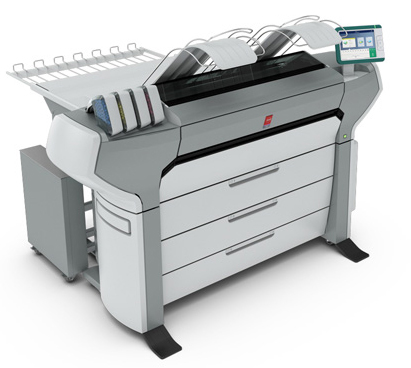How a Large-Format Printing System Works

The new Océ ColorWave 700 large-format black & white and color printing system can print up to 212 D-size full-color prints per hour. The print engine at its heart leverages Océ CrystalPoint Technology to provide high-resolution results on media as diverse as economical uncoated recycled paper and high-end specialty materials. Image courtesy of Canon Solutions America Inc.
February 22, 2018
Canon Solutions America recently announced that 10,000 Océ ColorWave engines have been installed in high-tech engineering and manufacturing outfits of every size worldwide as of last December. That's a few months shy of the 10th anniversary of the technology's 2008 introduction. Suffice to say, that's a lot of systems handling CAD, GIS, plotting, reprography as well as good old scan and copy jobs.
Océ CrystalPoint imaging technology lies at the core of the Océ ColorWave portfolio, including the new generation Océ ColorWave 500 and the Océ ColorWave 700 large-format printing systems. Both of these systems provide high-quality (600 dpi) monochrome and color printing. They provide cloud integration, multiple user support, security features and a slew of integrated media and output options.
 The new Océ ColorWave 700 large-format black & white and color printing system can print up to 212 D-size full-color prints per hour. The print engine at its heart leverages Océ CrystalPoint Technology to provide high-resolution results on media as diverse as economical uncoated recycled paper and high-end specialty materials. Image courtesy of Canon Solutions America Inc.
The new Océ ColorWave 700 large-format black & white and color printing system can print up to 212 D-size full-color prints per hour. The print engine at its heart leverages Océ CrystalPoint Technology to provide high-resolution results on media as diverse as economical uncoated recycled paper and high-end specialty materials. Image courtesy of Canon Solutions America Inc.Still, with 10,000 Océ ColorWave engines deployed, it's likely you have worked with one through your central print room or across the workgroup floor, so you know that stuff. But what do you know about Océ CrystalPoint imaging technology? Beyond loading those see-through ink cartridges filled with colored balls and your engineering training-based guesses, how does it really work? The tech brief at the other side of today's Check it Out link answers that question.
Simply titled “Océ CrystalPoint Technology,” this is a fascinating read. The paper explains the Océ CrystalPoint printing process from the underlying concept on up. For example, those little colored balls? They're called Océ TonerPearls. They embody a concept called Solid-In Solid-Out (SISO) toner. Essentially, SISO melts the balls into a toner gel that gets jetted and crystallized onto the media.
The paper also introduces and explains Océ PAINT, a subsidiary technology that Océ CrystalPoint enables in the latest generation of Océ ColorWave printing systems. PAINT stands for Piezo Acoustic Integrated Nozzle Technology. Its palette of automated diagnostic, maintenance and error correction routines can extend a system's lifetime by correcting for common issues like paper touches that can cause print nozzle failures.
A strength of “Océ CrystalPoint Technology” is that it eschews getting into heavy chemistry and physics. Rather, it explains Océ CrystalPoint imaging technology in a way that should engage intellectually curious engineers as well as smart non-techies who overlord the corporate checkbooks. And while it delves into benefits such as green technology support, it does so without beating you over the head (kudos for that). In short, this tech brief is a good use of your time. Click the link for your complimentary copy.
Thanks, Pal. – Lockwood
Anthony J. Lockwood
Editor at Large, DE
Subscribe to our FREE magazine, FREE email newsletters or both!
About the Author
Anthony J. Lockwood is Digital Engineering’s founding editor. He is now retired. Contact him via [email protected].
Follow DE







